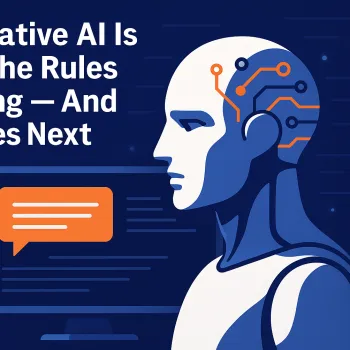Small Business Survival Guide: 5 Pain Points That Kill Growth (and How to Fix Them Fast)
By:
Miha Ella
On
08/04/2025Reading time:
5 min
Summary:
Running a small business or startup today isn’t just about hustle—it’s about surviving daily battles that drain energy, budget, and time.
From freelancers to small teams, most founders face the same invisible killers of growth. If you're tired of spinning your wheels and wondering why results aren’t coming fast enough, this guide is your map out of chaos.
Let’s break down five deadly pain points and explore how to resolve them effectively.

A cheerful flat-style illustration showing a small business owner overwhelmed by tools, but still hopeful.
Cash Flow Chaos
One of the most common issues small business owners face is the persistent challenge of cash flow instability. Even when sales are coming in, the bank balance often teeters dangerously low. This usually stems from poor invoice tracking, delayed client payments, and unpredictable expenses.
To overcome this, it is crucial to implement automated invoicing tools or set up a Notion dashboard that provides a clear overview of payment statuses. Offering small discounts to clients who pay early can also encourage faster cash inflow. Creating a financial buffer—such as one month of operating cash in reserve—provides additional security.
Regular monitoring of your monthly expenses helps identify where money leaks might be occurring. A useful enhancement is pairing your financial setup with an AI-driven notification system that alerts you to overdue payments.
Tool Paralysis (Too Many, Too Useless)
Many entrepreneurs fall into the trap of subscribing to countless free tools and apps, only to find that productivity suffers rather than improves.
The issue arises when each tool addresses a micro-need but fails to integrate with others, leading to constant tab switching and fragmented workflows. Conducting a tech stack audit is the first step toward clarity—determine which tools are truly essential. Then, consolidate your efforts by selecting one or two platforms that serve multiple functions. Testing a single AI agent capable of replacing several disjointed apps can also dramatically streamline your operations.
Using an AI Tool Advisor helps you evaluate and reduce your digital clutter in minutes.
No Repeat Customers = No Profit
Acquiring a customer is hard work—but keeping that customer is where real profit lives. If clients never return after the first sale, it’s often due to weak onboarding, a lack of follow-up, and the absence of emotional connection.
To combat this, design an engaging and personalized post-sale experience. Start by setting up an email sequence that says thank you while guiding the customer on what to do next. Offering a relevant upsell right after the first purchase can increase the average transaction value. Gathering feedback from customers enables you to personalize follow-ups more effectively.
Leveraging AI tools to generate customer-specific check-ins and offers based on their behavior makes your communication more impactful and relevant.
You Do Everything Yourself
Being a solo founder or small business owner often means wearing too many hats—founder, designer, accountant, customer support, and sometimes even janitor.
This is exhausting and leads to burnout. The underlying cause is often a reluctance to delegate, paired with a lack of established systems. Start by identifying one or two tasks per week that can be automated using simple AI agents. For tasks that cannot be automated, consider outsourcing them via micro-freelancer platforms.
Documenting your processes allows you to hand off execution more easily and confidently. Introducing a daily AI assistant to handle repetitive email responses can reclaim hours of your time each week.
Marketing Without Message
Many small businesses struggle with marketing. They post content, send newsletters, and sometimes run ads—but the results fall flat. The reason usually lies in poor messaging.
Businesses often broadcast generic information without connecting to their audience’s real problems. Instead of listing product features, shift focus to the customer’s primary pain point and craft stories around solving it. Every piece of content should communicate transformation, not just information. Creating feedback loops helps identify what your audience actually responds to, and A/B testing various headlines can reveal what truly resonates.
AI can support this process by generating multiple versions of your message and analyzing performance data to refine your communication.
Conclusion: Fix Fast, Grow Smarter
The truth is, most small businesses don’t fail because of bad ideas—they fail because of unresolved pain points that slowly chip away at their momentum.
What you need isn’t more hustle but better systems, smarter tools, and a growth strategy grounded in clarity and execution. If you’re ready to move beyond survival mode, start by reflecting on which of these challenges you’re facing right now. In the coming weeks, we’ll release tailored resources and action-ready kits that tackle each of these pain points step by step.
Subscribe to stay ahead—and take control of your growth journey.

Your Marketing Plan Is Dead. This AI Writes Itself — and Outsells You
Radu Timis
05.04.2025
The age of storytelling is ending. The age of synthetic persuasion has just begun.
You thought you knew what marketing was. Campaigns. Funnels. Content calendars. Maybe even a few clever slogans sprinkled with A/B tests and performance metrics. But that world is dissolving — fast. And in its place, something radically different is forming: generative marketing intelligence that thinks, speaks, and evolves on its own.
This isn’t automation. This is creation.
Welcome to the era where brands don’t just talk to customers. They simulate conversations. They anticipate emotions. They generate trust — on demand.

AI Agents: Revolutionizing Industries or Overhyped Hype? A Balanced Look at the Future
Miha Ella
15.02.2025
Artificial Intelligence (AI) is no longer a futuristic concept—it’s already here, reshaping industries, workflows, and even daily life. From automating customer service to optimizing supply chains, AI agents are being heralded as the next big revolution. But is this transformation as inevitable and beneficial as many claim? Or are AI agents still in their infancy, prone to inefficiencies, security risks, and ethical concerns?
In this article, we’ll explore both perspectives—the excitement and the skepticism—to provide a clear, balanced view of AI’s impact on business and society. By understanding both sides, we can prepare for a future that is not just AI-driven, but human-guided.

Stop Working Like a Robot: Let AI Handle It—Here’s How to Get Your Life Back
Radu Timis
28.03.2025
This article explores how AI can liberate us from routine tasks and help reclaim our time, energy, and purpose. Instead of fearing automation, it reframes AI as a tool for designing a more intentional, human-centered life. Through practical examples and mindset shifts, it empowers readers to let machines handle the boring stuff—so they can start truly living.
Subscribe to our newsletter
Stay in touch and be the first to be informed with the latest news!
